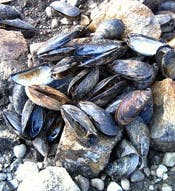Metropolitan Water District’s Board of Directors authorized a range of additional actions aimed at stepping up efforts to help contain the spread of quagga mussels in key sections of Southern California’s regional imported water system.
Metropolitan’s board appropriated $5.9 million to design and build chlorination facilities at crucial district reservoirs, including Diamond Valley Lake in southwest Riverside County, and to design isolation barriers along the 242-mile Colorado River Aqueduct.
Along with facility upgrades, Metropolitan will intensify boat inspections at Diamond Valley Lake and Lake Skinner through enhanced training for reservoir operators and marina staff.
“The pace at which we’ve ramped up our comprehensive efforts to control the proliferation of quagga mussels in our water sources that supply 18 million Southern Californians demonstrates how seriously we are taking this threat,” said Timothy F. Brick, Metropolitan board chairman.
“We plan to take whatever actions are necessary to manage the number of quagga in our source waters, particularly along the Colorado River Aqueduct and in our reservoirs,” Brick added. “As the region’s primary imported water provider, we have an obligation to exhaust all available options to help quell the quagga.”
Introduced to U.S. waterways from Ukraine about two decades ago in the ballast tanks of large container ships, quagga mussels are an invasive species that disrupts and ruins traditional aquatic ecosystems, primarily freshwater lakes. The tiny freshwater bivalve mollusk, along with the similar zebra mussels, has severely affected water infrastructure in the Great Lakes and has caused billions of dollars of damage by clogging pipes, water pumps and other water systems, primarily on the Atlantic Coast.
Since being discovered at the intake of Metropolitan’s aqueduct system last January, mussels have been detected by Metropolitan during system-wide shutdowns and inspections along the entire length of the aqueduct.
Under the first phase of the mussel control program, initiated by Metropolitan’s board in February, the district purchased portable decontamination units, deep-water surveillance and sampling equipment, as well as a polarizing microscope to increase surveillance of Metropolitan’s aqueduct and to conduct laboratory tests for mussel larvae.
The second phase of the mussel control program calls for the design and construction of interim and permanent disinfection facilities that will provide a continuous level of treatment to Metropolitan’s supplies at the outlets at Copper Basin, a reservoir near the beginning of the aqueduct system, Lake Mathews and Diamond Valley Lake.
Additional upgrades include the installation of hydraulic isolation barriers--such as drop-gates, valves, floating bulkheads or stop-logs--that can segregate segments of the aqueduct system for treatment, thereby avoiding the need for complete system-wide shutdowns.
Metropolitan also will initiate a training course recognized by the National Association of State Boating Law Administrators and many state and federal resource agencies to upgrade boat inspections at Diamond Valley and Skinner. Recreation operators and marina staff at both lakes will be asked to complete the course to improve inspections to NASBLA standards.
Source: Metropolitan Water District of Southern California


